DISCOVER Vol. 24 No. 5 (May 2003)
Table of Contents
Anything into
Oil
Technological savvy could turn 600 million tons of turkey
guts and other waste into 4 billion barrels of light Texas crude each year
By Brad Lemley
Photography by Tony Law
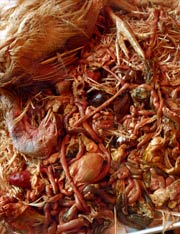 | |
| Gory refuse, from a Butterball Turkey plant in Carthage, Missouri, will no longer go to waste. Each day 200 tons of turkey offal will be carted to the first industrial-scale thermal depolymerization plant, recently completed in an adjacent lot, and be transformed into various useful products, including 600 barrels of light oil. | |
In an industrial park in Philadelphia sits a new machine that can change almost anything into oil.
Really.
"This is a solution to three of the biggest problems facing mankind," says Brian Appel, chairman and CEO of Changing World Technologies, the company that built this pilot plant and has just completed its first industrial-size installation in Missouri. "This process can deal with the world's waste. It can supplement our dwindling supplies of oil. And it can slow down global warming."
Pardon me, says a reporter, shivering in the frigid dawn, but that sounds too good to be true.
"Everybody says that," says Appel. He is a tall, affable entrepreneur who has assembled a team of scientists, former government leaders, and deep-pocketed investors to develop and sell what he calls the thermal depolymerization process, or TDP. The process is designed to handle almost any waste product imaginable, including turkey offal, tires, plastic bottles, harbor-dredged muck, old computers, municipal garbage, cornstalks, paper-pulp effluent, infectious medical waste, oil-refinery residues, even biological weapons such as anthrax spores. According to Appel, waste goes in one end and comes out the other as three products, all valuable and environmentally benign: high-quality oil, clean-burning gas, and purified minerals that can be used as fuels, fertilizers, or specialty chemicals for manufacturing.
Unlike other solid-to-liquid-fuel processes such as cornstarch into ethanol, this one will accept almost any carbon-based feedstock. If a 175-pound man fell into one end, he would come out the other end as 38 pounds of oil, 7 pounds of gas, and 7 pounds of minerals, as well as 123 pounds of sterilized water. While no one plans to put people into a thermal depolymerization machine, an intimate human creation could become a prime feedstock. "There is no reason why we can't turn sewage, including human excrement, into a glorious oil," says engineer Terry Adams, a project consultant. So the city of Philadelphia is in discussion with Changing World Technologies to begin doing exactly that.
"The potential is unbelievable," says Michael Roberts, a senior chemical engineer for the Gas Technology Institute, an energy research group. "You're not only cleaning up waste; you're talking about distributed generation of oil all over the world."
"This is not an incremental change. This is a big, new step," agrees Alf Andreassen, a venture capitalist with the Paladin Capital Group and a former Bell Laboratories director.
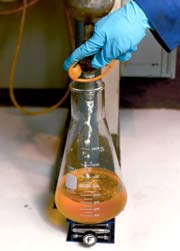 | |
| The offal-derived oil, is chemically almost identical to a number two fuel oil used to heat homes. | |
Andreassen and others anticipate that a large chunk of the world's agricultural, industrial, and municipal waste may someday go into thermal depolymerization machines scattered all over the globe. If the process works as well as its creators claim, not only would most toxic waste problems become history, so would imported oil. Just converting all the U.S. agricultural waste into oil and gas would yield the energy equivalent of 4 billion barrels of oil annually. In 2001 the United States imported 4.2 billion barrels of oil. Referring to U.S. dependence on oil from the volatile Middle East, R. James Woolsey, former CIA director and an adviser to Changing World Technologies, says, "This technology offers a beginning of a way away from this."
But first things first. Today, here at the plant at Philadelphia's Naval Business Center, the experimental feedstock is turkey processing-plant waste: feathers, bones, skin, blood, fat, guts. A forklift dumps 1,400 pounds of the nasty stuff into the machine's first stage, a 350-horsepower grinder that masticates it into gray brown slurry. From there it flows into a series of tanks and pipes, which hum and hiss as they heat, digest, and break down the mixture. Two hours later, a white-jacketed technician turns a spigot. Out pours a honey-colored fluid, steaming a bit in the cold warehouse as it fills a glass beaker.
It really is a lovely oil.
"The longest carbon chains are C-18 or so," says Appel, admiring the liquid. "That's a very light oil. It is essentially the same as a mix of half fuel oil, half gasoline."
Private investors, who have chipped in $40 million to develop the process, aren't the only ones who are impressed. The federal government has granted more than $12 million to push the work along. "We will be able to make oil for $8 to $12 a barrel," says Paul Baskis, the inventor of the process. "We are going to be able to switch to a carbohydrate economy."
Making oil and gas from hydrocarbon-based waste is a trick that Earth
mastered long ago. Most crude oil comes from one-celled plants and animals
that die, settle to ocean floors, decompose, and are mashed by sliding
tectonic plates, a process geologists call subduction. Under pressure and
heat, the dead creatures' long chains of hydrogen, oxygen, and
carbon-bearing molecules, known as polymers, decompose into short-chain
petroleum hydrocarbons. However, Earth takes its own sweet time doing
this—generally thousands or millions of years—because subterranean heat
and pressure changes are chaotic. Thermal depolymerization machines
turbocharge the process by precisely raising heat and pressure to levels
that break the feedstock's long molecular bonds.
Many
scientists have tried to convert organic solids to liquid fuel using waste
products before, but their efforts have been notoriously inefficient. "The
problem with most of these methods was that they tried to do the
transformation in one step—superheat the material to drive off the water
and simultaneously break down the molecules," says Appel. That leads to
profligate energy use and makes it possible for hazardous substances to
pollute the finished product. Very wet waste—and much of the world's waste
is wet—is particularly difficult to process efficiently because driving
off the water requires so much energy. Usually, the Btu content in the
resulting oil or gas barely exceeds the amount needed to make the stuff.
That's the challenge that Baskis, a microbiologist and
inventor who lives in Rantoul, Illinois, confronted in the late 1980s. He
says he "had a flash" of insight about how to improve the basic ideas
behind another inventor's waste-reforming process. "The prototype I saw
produced a heavy, burned oil," recalls Baskis. "I drew up an improvement
and filed the first patents." He spent the early 1990s wooing investors
and, in 1996, met Appel, a former commodities trader. "I saw what this
could be and took over the patents," says Appel, who formed a partnership
with the Gas Technology Institute and had a demonstration plant up and
running by 1999.
Thermal depolymerization, Appel says,
has proved to be 85 percent energy efficient for complex feedstocks, such
as turkey offal: "That means for every 100 Btus in the feedstock, we use
only 15 Btus to run the process." He contends the efficiency is even
better for relatively dry raw materials, such as plastics.
So how does it work? In the cold Philadelphia warehouse, Appel
waves a long arm at the apparatus, which looks surprisingly low tech: a
tangle of pressure vessels, pipes, valves, and heat exchangers terminating
in storage tanks. It resembles the oil refineries that stretch to the
horizon on either side of the New Jersey Turnpike, and in part, that's
exactly what it is.
Appel strides to a silver gray
pressure tank that is 20 feet long, three feet wide, heavily insulated,
and wrapped with electric heating coils. He raps on its side. "The chief
difference in our process is that we make water a friend rather than an
enemy," he says. "The other processes all tried to drive out water. We
drive it in, inside this tank, with heat and pressure. We super-hydrate
the material." Thus temperatures and pressures need only be modest,
because water helps to convey heat into the feedstock. "We're talking
about temperatures of 500 degrees Fahrenheit and pressures of about 600
pounds for most organic material—not at all extreme or energy intensive.
And the cooking times are pretty short, usually about 15 minutes."
Once the organic soup is heated and partially
depolymerized in the reactor vessel, phase two begins. "We quickly drop
the slurry to a lower pressure," says Appel, pointing at a branching
series of pipes. The rapid depressurization releases about 90 percent of
the slurry's free water. Dehydration via depressurization is far cheaper
in terms of energy consumed than is heating and boiling off the water,
particularly because no heat is wasted. "We send the flashed-off water
back up there," Appel says, pointing to a pipe that leads to the beginning
of the process, "to heat the incoming stream."
At this
stage, the minerals—in turkey waste, they come mostly from bones—settle
out and are shunted to storage tanks. Rich in calcium and magnesium, the
dried brown powder "is a perfect balanced fertilizer," Appel says.
The remaining concentrated organic soup gushes into a
second-stage reactor similar to the coke ovens used to refine oil into
gasoline. "This technology is as old as the hills," says Appel, grinning
broadly. The reactor heats the soup to about 900 degrees Fahrenheit to
further break apart long molecular chains. Next, in vertical distillation
columns, hot vapor flows up, condenses, and flows out from different
levels: gases from the top of the column, light oils from the upper
middle, heavier oils from the middle, water from the lower middle, and
powdered carbon—used to manufacture tires, filters, and printer
toners—from the bottom. "Gas is expensive to transport, so we use it
on-site in the plant to heat the process," Appel says. The oil, minerals,
and carbon are sold to the highest bidders.
Depending on
the feedstock and the cooking and coking times, the process can be tweaked
to make other specialty chemicals that may be even more profitable than
oil. Turkey offal, for example, can be used to produce fatty acids for
soap, tires, paints, and lubricants. Polyvinyl chloride, or PVC—the stuff
of house siding, wallpapers, and plastic pipes—yields hydrochloric acid, a
relatively benign and industrially valuable chemical used to make cleaners
and solvents. "That's what's so great about making water a friend," says
Appel. "The hydrogen in water combines with the chlorine in PVC to make it
safe. If you burn PVC [in a municipal-waste incinerator], you get
dioxin—very toxic."
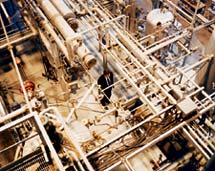 | |
| Brian Appel, CEO of Changing World Technologies, strolls through a thermal depolymerization plant in Philadelphia. Experiments at the pilot facility revealed that the process is scalable—plants can sprawl over acres and handle 4,000 tons of waste a day or be "small enough to go on the back of a flatbed truck" and handle just one ton daily, says Appel. | |
The technicians here have spent three years feeding different kinds of waste into their machinery to formulate recipes. In a little trailer next to the plant, Appel picks up a handful of one-gallon plastic bags sent by a potential customer in Japan. The first is full of ground-up appliances, each piece no larger than a pea. "Put a computer and a refrigerator into a grinder, and that's what you get," he says, shaking the bag. "It's PVC, wood, fiberglass, metal, just a mess of different things. This process handles mixed waste beautifully." Next to the ground-up appliances is a plastic bucket of municipal sewage. Appel pops the lid and instantly regrets it. "Whew," he says. "That is nasty."
Experimentation revealed that different waste streams require different cooking and coking times and yield different finished products. "It's a two-step process, and you do more in step one or step two depending on what you are processing," Terry Adams says. "With the turkey guts, you do the lion's share in the first stage. With mixed plastics, most of the breakdown happens in the second stage." The oil-to-mineral ratios vary too. Plastic bottles, for example, yield copious amounts of oil, while tires yield more minerals and other solids. So far, says Adams, "nothing hazardous comes out from any feedstock we try."
"The only thing this process can't handle is nuclear waste," Appel says. "If it contains carbon, we can do it." à
This Philadelphia pilot plant can handle only seven tons of waste a day, but 1,054 miles to the west, in Carthage, Missouri, about 100 yards from one of ConAgra Foods' massive Butterball Turkey plants, sits the company's first commercial-scale thermal depolymerization plant. The $20 million facility, scheduled to go online any day, is expected to digest more than 200 tons of turkey-processing waste every 24 hours.
The north side of Carthage smells like Thanksgiving all the time. At
the Butterball plant, workers slaughter, pluck, parcook, and package
30,000 turkeys each workday, filling the air with the distinctive tang of
boiling bird. A factory tour reveals the grisly realities of large-scale
poultry processing. Inside, an endless chain of hanging carcasses clanks
past knife-wielding laborers who slash away. Outside, a tanker truck
idles, full to the top with fresh turkey blood. For many years, ConAgra
Foods has trucked the plant's waste—feathers, organs, and other nonusable
parts—to a rendering facility where it was ground and dried to make animal
feed, fertilizer, and other chemical products. But bovine spongiform
encephalopathy, also known as mad cow disease, can spread among cattle
from recycled feed, and although no similar disease has been found in
poultry, regulators are becoming skittish about feeding animals to
animals. In Europe the practice is illegal for all livestock. Since 1997,
the United States has prohibited the feeding of most recycled animal waste
to cattle. Ultimately, the specter of European-style mad-cow regulations
may kick-start the acceptance of thermal depolymerization. "In Europe,
there are mountains of bones piling up," says Alf Andreassen. "When
recycling waste into feed stops in this country, it will change
everything."
Because depolymerization takes apart
materials at the molecular level, Appel says, it is "the perfect process
for destroying pathogens." On a wet afternoon in Carthage, he smiles at
the new plant—an artless assemblage of gray and dun-colored buildings—as
if it were his favorite child. "This plant will make 10 tons of gas per
day, which will go back into the system to make heat to power the system,"
he says. "It will make 21,000 gallons of water, which will be clean enough
to discharge into a municipal sewage system. Pathological vectors will be
completely gone. It will make 11 tons of minerals and 600 barrels of oil,
high-quality stuff, the same specs as a number two heating oil." He shakes
his head almost as if he can't believe it. "It's amazing. The
Environmental Protection Agency doesn't even consider us waste handlers.
We are actually manufacturers—that's what our permit says. This process
changes the whole industrial equation. Waste goes from a cost to a
profit."
He watches as burly men in coveralls weld and
grind the complex loops of piping. A group of 15 investors and corporate
advisers, including Howard Buffett, son of billionaire investor Warren
Buffett, stroll among the sparks and hissing torches, listening to a tour
led by plant manager Don Sanders. A veteran of the refinery business,
Sanders emphasizes that once the pressurized water is flashed off, "the
process is similar to oil refining. The equipment, the procedures, the
safety factors, the maintenance—it's all proven technology."
And it will be profitable, promises Appel. "We've done so much
testing in Philadelphia, we already know the costs," he says. "This is our
first-out plant, and we estimate we'll make oil at $15 a barrel. In three
to five years, we'll drop that to $10, the same as a medium-size oil
exploration and production company. And it will get cheaper from there."
"We've got a lot of confidence in this," Buffett says.
"I represent ConAgra's investment. We wouldn't be doing this if we didn't
anticipate success." Buffett isn't alone. Appel has lined up federal grant
money to help build demonstration plants to process chicken offal and
manure in Alabama and crop residuals and grease in Nevada. Also in the
works are plants to process turkey waste and manure in Colorado and pork
and cheese waste in Italy. He says the first generation of
depolymerization centers will be up and running in 2005. By then it should
be clear whether the technology is as miraculous as its backers claim.
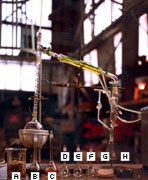
EUREKA:
Chemistry, not alchemy, turns (A) turkey offal—guts, skin, bones, fat, blood, and feathers—into a variety of useful products. After the first-stage heat-and-pressure reaction, fats, proteins, and carbohydrates break down into (B) carboxylic oil, which is composed of fatty acids, carbohydrates, and amino acids. The second-stage reaction strips off the fatty acids' carboxyl group (a carbon atom, two oxygen atoms, and a hydrogen atom) and breaks the remaining hydrocarbon chains into smaller fragments, yielding (C) a light oil. This oil can be used as is, or further distilled (using a larger version of the bench-top distiller in the background) into lighter fuels such as (D) naphtha, (E) gasoline, and (F) kerosene. The process also yields (G) fertilizer-grade minerals derived mostly from bones and (H) industrially useful carbon black.
Garbage In, Oil Out
Feedstock is funneled into a grinder and mixed with water to create a
slurry that is pumped into the first-stage reactor, where heat and
pressure partially break apart long molecular chains. The resulting
organic soup flows into a flash vessel where pressure drops dramatically,
liberating some of the water, which returns back upstream to preheat the
flow into the first-stage reactor. In the second-stage reactor, the
remaining organic material is subjected to more intense heat, continuing
the breakup of molecular chains. The resulting hot vapor then goes into
vertical distillation tanks, which separate it into gases, light oils,
heavy oils, water, and solid carbon. The gases are burned on-site to make
heat to power the process, and the water, which is pathogen free, goes to
a municipal waste plant. The oils and carbon are deposited in storage
tanks, ready for sale.
— Brad Lemley
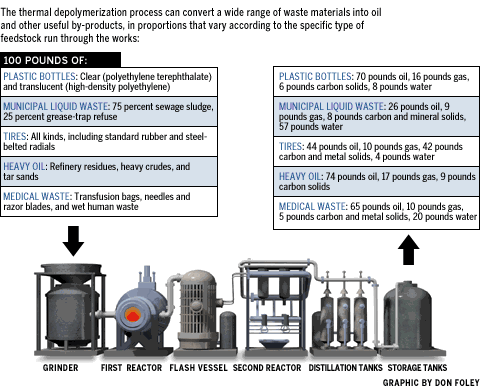
A Boon to Oil and Coal Companies
One might expect fossil-fuel companies to fight thermal
depolymerization. If the process can make oil out of waste, why would
anyone bother to get it out of the ground? But switching to an energy
economy based entirely on reformed waste will be a long process, requiring
the construction of thousands of thermal depolymerization plants. In the
meantime, thermal depolymerization can make the petroleum industry itself
cleaner and more profitable, says John Riordan, president and CEO of the
Gas Technology Institute, an industry research organization. Experiments
at the Philadelphia thermal depolymerization plant have converted heavy
crude oil, shale, and tar sands into light oils, gases, and graphite-type
carbon. "When you refine petroleum, you end up with a heavy solid-waste
product that's a big problem," Riordan says. "This technology will convert
these waste materials into natural gas, oil, and carbon. It will fit right
into the existing infrastructure."
Appel says a modified
version of thermal depolymerization could be used to inject steam into
underground tar-sand deposits and then refine them into light oils at the
surface, making this abundant, difficult-to-access resource far more
available. But the coal industry may become thermal depolymerization's
biggest fossil-fuel beneficiary. "We can clean up coal dramatically," says
Appel. So far, experiments show the process can extract sulfur, mercury,
naphtha, and olefins—all salable commodities—from coal, making it burn
hotter and cleaner. Pretreating with thermal depolymerization also makes
coal more friable, so less energy is needed to crush it before combustion
in electricity-generating plants.
— B.L.
Can Thermal Depolymerization Slow Global Warming?
If the thermal depolymerization process WORKS AS Claimed, it will clean
up waste and generate new sources of energy. But its backers contend it
could also stem global warming, which sounds iffy. After all, burning oil
creates global warming, doesn't it?
Carbon is the major
chemical constituent of most organic matter—plants take it in; animals eat
plants, die, and decompose; and plants take it back in, ad infinitum.
Since the industrial revolution, human beings burning fossil fuels have
boosted concentrations of atmospheric carbon more than 30 percent,
disrupting the ancient cycle. According to global-warming theory, as
carbon in the form of carbon dioxide accumulates in the atmosphere, it
traps solar radiation, which warms the atmosphere—and, some say, disrupts
the planet's ecosystems.
But if there were a global
shift to thermal depolymerization technologies, belowground carbon would
remain there. The accoutrements of the civilized world—domestic animals
and plants, buildings, artificial objects of all kinds—would then be
regarded as temporary carbon sinks. At the end of their useful lives, they
would be converted in thermal depolymerization machines into short-chain
fuels, fertilizers, and industrial raw materials, ready for plants or
people to convert them back into long chains again. So the only carbon
used would be that which already existed above the surface; it could no
longer dangerously accumulate in the atmosphere. "Suddenly, the whole
built world just becomes a temporary carbon sink," says Paul Baskis,
inventor of the thermal depolymerization process. "We would be honoring
the balance of nature."
— B.L.
RELATED WEB SITES:
To learn more about the thermal depolymerization process, visit Changing World Technologies' Web site: http://www.changingworldtech.com/.
A primer on the natural carbon cycle can be found at www.whrc.org/science/carbon/carbon.htm.
© Copyright 2003 The Walt Disney Company. Back to Homepage.